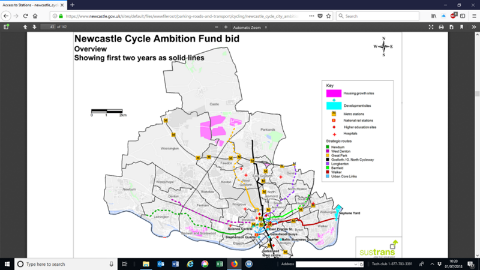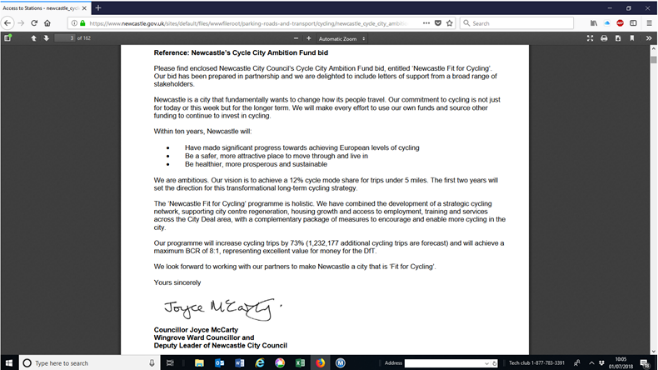Blog
Read All About It!
Let me introduce you to CMI, Chronic Mental Inertia – For the In-tray of Simon Case, the new Cabinet Secretary
It has been my considerable misfortune since my retirement to witness at close quarters the dire consequences of forming policies on the basis of “wouldn’t it be nice if…” and building empires on foundations of sand.

I have seen it twice. Special Education and Inclusion on the first occasion, and cycle lanes the second. SCROLL FORWARD TO CYCLE LANES IF THAT IS WHAT YOU ARE MOST INTERESTED IN AND PLEASE READ TO THE END.
Special Educational Needs
With Inclusion this is best illustrated with the SALAMANCA STATEMENT: NETWORK for ACTION on SPECIAL NEEDS EDUCATION Adopted by the World Conference on Special Needs Education: Access and Quality Salamanca, Spain, 7-10 June 1994 Organised by the Government of Spain and UNESCO.
- those with special educational needs must have access to regular schools
- regular schools with an inclusive ethos are the most effective way to combat discriminatory attitudes, create welcoming and inclusive communities and achieve education for all
- such schools provide effective education to the majority of children and improve efficiency with cost- effectiveness. <my underlining>
It is also people typified by Phil Wills MP, former Lib Dem spokesman for Education, said in the Commons on 20 March 2001: “Working in Chapeltown in the late 1960’s convinced me that unless we could educate the whole community together – wherever they came from and whatever their needs and disabilities – frankly we would breed dysfunctional communities. It is a point of principle to me and my colleagues that inclusive education goes to the heart of the education system.”
On the back of this, in the UK, over 100 special schools -some particularly good ones – were closed despite parental opposition. I describe this as civic vandalism.
As the saying goes, the road to Hell is paved with good intentions.
Professional care for detail went out of the window. Rights were created but for many they conveyed no benefit whatsoever. Concern for the rights of those adversely affected were of no matter. They never are. The idealists inveigled their way into Central and Local Government. The media and the legal profession in their ignorance of the facts on the ground bought into it.
The price – and to this day – children with special needs are given an equal opportunity to go to University when for many of them what they simply wanted was opportunity. The key word is not Equality but Liberty; an education that frees them to find their own innate talent, the message that the late Prof. Ken Robinson preached for the whole of education. Or, as I have been saying it, at the end of their schooling children should feel a sense of personal value, self-esteem – not in the case of half of them – a sense of failure to get into Uni. Denied a curriculum that made sense for them, a joy and a stimulation for them to study, and a value for the rest of their lives.
Bullying in mainstream, now cyber-bullying was never anticipated. The specialist teacher time required was never acknowledged and thousands of NTAs substituted. The effect on the teaching of other children was totally irrelevant. Human fallibility, as always, was never factored in. Read my book Death of a Nightingale with ispy or visit my website www.deathofanightingale.com if you want to see all the unexpected consequences.
Tragically, one of them, Covid-19 has probably exacerbated the problem; the schools that could have provided for children with special needs since March did not exist.
As chair of Governors, I saw this in Sunderland where I witnessed the Local Labour Council’s attempt to starve a school to death by denying it the funds to employ its staff. We were rescued by the parents’ campaign and by a legacy!

And now cycle lanes.
Here this is best illustrated by Sustrans, the cycling charity, lobby and shamateur road planner that has successfully inveigled its way into both Central and Local Government. This is their “wouldn’t it be nice if …” vision:
SUSTRANS Annual Review 2013-2014
“By 2020, four out of five local journeys will be made by bike, foot or public transport.”
“We think a street should be designed for residents rather than those driving through, with slower speeds and slower moving traffic, so people are more inclined to walk and cycle for their journeys, some or all of the way .” <my underlining>
A strident minority went along with it. A silent majority hated it.
Once again blind optimism ruled the day. £billions thrown at it. Rights were created to promote it – the right to clean air. In their ignorance of facts on the ground the media bought into it. It sells newspapers or audience time. The legal profession went with the flow. The only world they see with total clarity lies within the walls of the Houses of Parliament and HM Courts of Justice. Whitehall’s mandarins again marble-less in marbled corridors, the Ministry for Transport morphing into the Ministry for the creation of Bottlenecks.
They are all ignorant of danger. RoSPA’s stats rely only on injuries reported to the police not on NHS stats that must be there. A simplistic belief by the flat earthers that what the Dutch do in little Holland can be replicated in UK’s towns and cities with our narrow, busy urban roads, our 10,000 roundabouts, and our potholes and on our narrow, twisting picturesque rural roads and lanes between high hedge rows.
What do they expect? With a few new segregated cycle lanes, tens of thousands of frustrated motorists in UK, fined £100 for speeding over 20mph and shortly to be fined £70 for parking on the curb to create more road space, will immediately dash out and buy bikes for all the family. Ho Ho. Never mind rain, gale force winds, and wintry sleet and slush soon to come.
Never mind the increased congestion they cause. Never mind that the priority should be providing fast chargers for the EV revolution the world’s auto industry is currently preparing itself for. Never mind that the High Streets of the UK need the lifeblood that motorists can provide if they were made welcome not treated like lepers.
I saw this in Newcastle.
Drawing a black line on a street map with a crayon for a cycle lane was the easy bit. They didn’t see the bottleneck on Gosforth High Street where the width of an arterial road for heavy traffic and a shopping street combined is narrower than the width of four bus stops. I had it measured.

Here are the National Cycling to Work stats for Newcastle 1,781 in 2001 rising to 3,223 in 2011.
And a local survey on Gosforth High Street recorded only about 70 cycling journeys daily, probably 35 cyclists with return journeys.
Yet, the local Project Manager for cycle lanes and red lines wrote to Mr. C. Thorpe, a successful local trader objecting, “We are tasked with growing cycling in the city to a significant proportion of all trips under five miles. On numbers this could easily mean that to be successful we will need to see up to 3,000 cyclists a day using this corridor to comply with 20% of all trips under five miles.”

And the local Labour council adopted Sustrans’ precisely calculated forecast of 1,232,177 additional cycling trips.
Imagine 3,000 cyclists daily using this corridor. Imagine even 300.

Pop-up Cycle lane on Gosforth High Street
Pop-up cycle lanes are supposed to be temporary. I hope this one is very temporary.
Here pop-up cycle lanes are on one side only of Gosforth High Street, not segregated, sometimes abbreviated – cyclists in single file right next to a long toxic traffic tail back of buses, cars, vans and lorries, free clean air in particularly short supply, and a little local difficulty for the emergency services to contend with. With artistic licence Sustrans’ designed consultation for the local authority envisaged two-way cycle lanes and red lines here! As it is, cyclists on their return journeys must either ride the pavement or fight for space with those buses, cars, vans, and lorries. Today I saw a handful of cyclists do both.
This is a far cry from Copenhagen, Amsterdam &c. where everything is different.
The calamitous performance of Corbyn’s Labour Party and the near-demise of the LibDems in the Brexit Election of December 2019 brings back to my mind the little story I told at the end of the Prologue to my book “Death of a Nightingale with Ispy.”
Two seriously ill patients go to see a doctor. He examines the first. “Oh dear” he says, “I am most terribly sorry, I cannot do anything here.” He then sees the second. “Oh dear, oh dear, oh dear, I must do something here.”
Here is my diagnosis: CMI – CHRONIC MENTAL INERTIA in high places, a partial explanation.
IS THIS ONE REASON WHY WE NEED SOMEONE NEW TO CLEAN OUT THE STABLE? GOOD LUCK, SIMON
PLEASE SHARE WITH YOUR FRIENDS & COLLEAGUES
WARNING Cycling may seriously damage your bones. Electric car is much safer.

Over 3,000,000 people in UK suffer from Osteoporosis. If you fall off your bike you can fracture your wrist, arm,collar bone, shoulder,pelvis, leg or cranium. And more work for the NHS treating you.
And bikes and scooters are hired out without helmets!
RoSPA doesn’t even know the number of serious injuries. Their latest report states that they rely only on those reported to the police. The actual number may be two or three times more. <Their stats are useless>
THE DEPARTMENT FOR TRANSPORT SHOULD ASK THE NHS FOR THE ACTUAL NUMBERS with details of age, sex and occupation. NO ONE EVER DOES.
Simon Cowell’s fall from his new electric trail bike should serve as a warning. He fractured his spine in six places. It is very lucky he is not a paraplegic.
If you can find somewhere to charge it, get an electric car as soon as you can and contribute to cleaner air.
PLEASE SHARE
What they don’t tell you about Cycling – You will prolong your life if you live that long
The Times 7 August 2020
STOP PRESS – SIMON COWELL HAS JUST BROKEN HIS BACK TRYING OUT HIS NEW ELECTRIC BIKE.

“That’s cycling, as Jonathan Vaughters, the former rider who is now head of the EF Pro Cycling team, noted a couple of years ago when he talked about the countless hospital visits, gory medical reports and horrific roadside scenes of his long experience.
“We, the old guard, are so vaccinated against feeling in cycling,” Vaughters wrote in a piece for CyclingTips. “A crash with a concussion, a broken nose and collarbone is seen as lucky. Healthy, really. ‘He’s fine’ will be the response to anyone who asks, and then the follow-up is really how many weeks before he can begin training again.
“These thoughts, words and responses seem truly insane to someone not tenured in the world of bicycle racing. And I guess that’s because they are.”
That’s cycling. We may gawp at the footage but those within the sport have to avoid thinking too deeply about the perilous risks when cyclists are hurtling wheel to wheel at crazy speeds dressed in Lycra.
“That is the great open secret of bike racing — how often and how terribly they crash,” Dan Coyle noted in Lance Armstrong’s War. They crash in sprints and flying down mountain passes, on greasy roundabouts and into bollards and fences and ditches on sun-melted tar.
They break backs and pelvises and particularly collarbones. Never mind road rash and saddle sores, Coyle estimated that there were about five serious injuries per week among the four hundred or so professional cyclists. Over a six-month season, that amounted to a one-in-four chance of time in hospital.“
RoSPA Road Safety Fact Sheet November 2017
Cyclist Casualties, 20162 Child (0-15) Adult All* Killed 8 94 102 Seriously injured 309 3,088 3,397 Slightly injured 1,664 13,314 14,978 Total 1,981 16,496 18,477
*All includes casualties where age not recorded
These figures only include cyclists killed or injured in road accidents that were reported to the police. Many cyclist casualties are not reported to the police, even when the cyclist is injured badly enough to be taken to hospital. The figures also exclude cycling accidents that occur away from the road. Although the number of deaths is accurate, there could be two or three times as many seriously injured cyclists and double the number of slightly injured.
<They just don’t know!>
The majority of cyclist casualties are adults, with approximately 10% being children. Cycling accidents increase as children grow older, with 10 to 15 year old riders being more at risk than other age groups, including adults until about the age of 60 years3 . To some extent, this reflects increased cycling as children grow older followed by a switch to motorised transport from the late teens onwards. It also coincides with the age when children attend Secondary school and may start to indicate riskier behaviour.
Males are far more likely to be involved in cycling accidents than females. In 2016, 81% of those injured in a reported road traffic accident were male4 . Almost two thirds of cyclists killed or seriously injured were involved in collisions at, or near, a road junction, with T-junctions being the most commonly involved. Roundabouts are particularly dangerous junctions for cyclists. Not surprisingly, the severity of injuries suffered by cyclists increases with the speed limit, meaning that riders are more likely to suffer serious or fatal injuries on higher speed roads.
Almost half of cyclist deaths occur on rural roads.
YOU DON’T HAVE TO RACE TO BE IN DANGER
PLEASE SHARE
